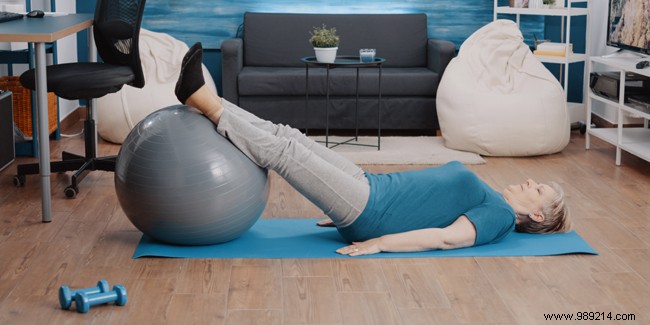
With age, the tissues present in our body relax. Among them, there is the skin but also the muscles. The perineum is affected. This muscle plays a major role since it supports many organs. A weakness of the perineum has serious consequences. One of them is incontinence. To reduce the risks, it is necessary to maintain your perineum. How ? Here are 5 exercises to practice to strengthen the perineum of the senior.
The perineum is therefore a muscle that is also called the pelvic floor. It extends from the pubis to the coccyx and takes the form of a hammock. The perineum supports all the organs located in the small pelvis, namely those that make up the genitalia and the anus. It is necessary to maintain your perineum throughout your life, because a weakness of this small muscle can have serious consequences on our daily life.
In women, a loss of tone in the perineum leads to:
In men, a loss of tone in the perineum leads to:
It should be noted that men and women are unequal with their perineum. The pelvic floor of women is wider and therefore has to bear more weight. However, during their lifetime, women are followed by a gynecologist. The weaknesses of the perineum are therefore identified more quickly. In addition, after childbirth, women must rehabilitate the perineum. They are therefore made aware of the importance of this muscle and know how to identify failures.
Sit in a chair trying to keep your back straight. Then, contract your perineum for 5 seconds then release for 10 seconds and repeat 10 times. Over the days, you can do contractions of 10 seconds. You have to work the front and back perineum. When you work the front perineum, you have to contract the muscles as if you were holding back urination. When you work the back part, you have to contract the muscle as if you were holding in flatulence. Breathing is very important during this exercise. You should inhale when you contract and exhale when you relax. It is possible to continue strengthening the perineum with a chair by doing the same exercise with the heels raised.
Another exercise, always with a chair or a ball, lie down on the ground and place your feet on it. Your arms should be alongside your body, palms facing the ceiling. Gently raise the pelvis then in series, try to raise the buttocks even higher for 10 seconds by contracting the perineum. Rest your pelvis and repeat 5 times. If you are comfortable, you can do sets of 10.
This exercise is easy and beneficial. this is the one we offer to young mothers! The principle is simple, lie down on the ground, place your hands behind your neck and place your right foot on your left knee. For the next series, alternate the placement of the legs. It is important to respect the location of the legs. If these are tense, your back will be hollow. Start by locking the perineum as if you wanted to block your orifices. Exhale all the air from your lungs and then inhale without taking in any air. Your belly should grow. Repeat this exercise 5 to 10 times, alternating the placement of the legs.
The lift exercise is very simple to perform. Position yourself as described in the false thoracic inspiration exercise. Contract the perineum. You will feel like the muscle is rising. Stop for 5 seconds at this first level then contract again to reach the next level. Do this until it is impossible to climb. Then relax the perineum and change the position of the legs before starting again 5 times.
For this last exercise, you will need to obtain a ball intended for the practice of Pilates. Lie on your back and place the ball between your legs. Using your knees, contract the ball. The contraction should last 5 seconds. When you contract, lock your perineum. During the next contraction, lock your abs. Repeat 10 times.
The exercises you do at home may not be enough. In this case, it is highly recommended to talk about it with your doctor, your gynecologist or your physiotherapist. An assessment will be prescribed to you in order to know if a rehabilitation is to be expected. This is done with a physiotherapist.
The practitioner can offer manual rehabilitation. He will guide you through the contractions, work by zone and appreciate the evolution. He may also suggest that you work with a probe. In women, the probe is placed in the vagina. More rarely, in case of faecal incontinence, an anal probe is used. In men, the physiotherapist will exclusively use an anal probe. These probes allow electrostimulation.
If the rehabilitation of the perineum is not enough, surgery can be considered. It is proposed in case of organ descent or severe incontinence. During the operation, the organs are put back in their place and fixed with a kind of net.
Losing weight is often necessary to strengthen the perineum. Pelvic floor weaknesses are more common when people are overweight or when they are obese. Thanks to a substantial weight loss, the perineum is less damaged. With a good rehabilitation of the perineum, disorders such as incontinence fade quickly.
It should be noted that if you suffer from incontinence, you should review your diet. It is necessary to reduce the consumption of spices, coffee or alcohol which act as stimulants for the bladder.
To maintain a healthy weight and good physical condition, sport is highly recommended. Thanks to a healthy lifestyle and regular physical activity, you delay aging and therefore the weaknesses of the perineum.
Too often, perineal weaknesses are detected late. However, early rehabilitation can restore an excellent quality of life. You have to dare to talk to your doctor about it. If you are bothered, change doctors. Incontinence affects nearly one in three people over the age of 65. That's a lot! So you are not alone.